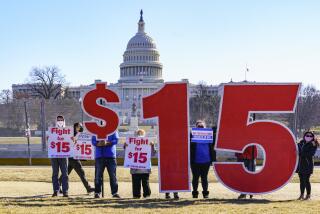U.S. poverty rate holds, but household incomes dip again
WASHINGTON -- Several years of rising poverty in the United States came to a halt in 2011 as more workers found full-time work, but overall household incomes on average continued a decade-long slide and inequality rose further last year, the government said Wednesday.
The Census Bureau’s annual report on income, poverty and health insurance coverage surprised analysts, who were projecting another tick up in the poverty rate, given the still-high unemployment rate and significant layoffs last year at local government offices. But the percentage of Americans living below the poverty line dipped to 15%, from 15.1% in 2010, a change considered statistically insignificant by the Census Bureau.
The poverty rate had gone up every year since 2007, but last year more people went from working part-time jobs to full-time ones. What’s more, the job gains benefited many workers in lower-income households, especially in the South, said David Johnson, a Census Bureau division chief.
There was also good news in the measure of the health insurance coverage rate. The number of people in the U.S. going without health coverage last year fell to 48.6 million, from 50 million in 2010. There was a notable decline in the uninsured among adults 19 to 25 years of age, suggesting that they were benefiting from the new healthcare law allowing them to go under their parents’ policies. And for the first time in a decade, the overall private medical-insurance coverage rate in the U.S. did not drop last year.
The census report, coming in the heat of the presidential campaign season, was cheered by the Obama administration, which has struggled to make an effective case that its economic policies are working amid repeatedly disappointing reports on employment and economic growth.
“It is clear that had President Obama not taken swift and aggressive action to grow our economy and create jobs, today’s report would have shown much higher poverty rates, lower incomes, and a greater share of the population without health insurance,” Rebecca Blank, the acting U.S. secretary of Commerce, said in a statement.
Still, at 15%, the share of Americans living in poverty is just a little less than multi-decade highs. Apart from this year and last, there were only three other years since the War on Poverty began in 1965 that the nation’s poverty rate was 15% or higher.
And there was no relief in the long-running trend of declining and stagnant incomes for most Americans: The median annual household income in the U.S. fell 1.5% last year from 2010, to $50,054. That is 8.1% lower than in 2007, when the Great Recession officially struck, and 8.9% less than in 1999.
ALSO:
Poverty, pregnancy and marriage: a conservative’s view
Middle-class income and wealth fell in last 10 years, survey shows
U.S. adds disappointing 96,000 jobs; August unemployment rate at 8.1%
More to Read
Inside the business of entertainment
The Wide Shot brings you news, analysis and insights on everything from streaming wars to production — and what it all means for the future.
You may occasionally receive promotional content from the Los Angeles Times.











